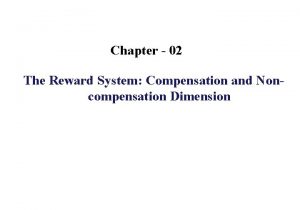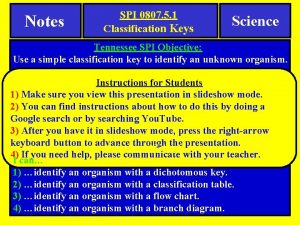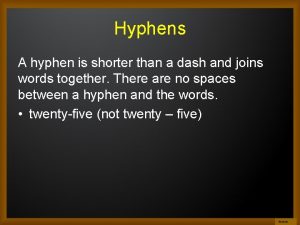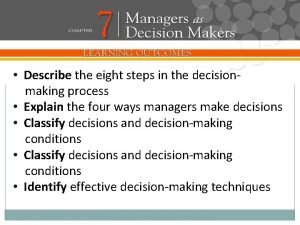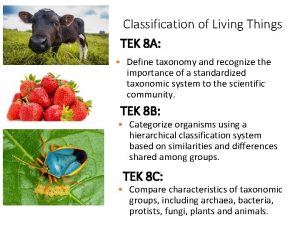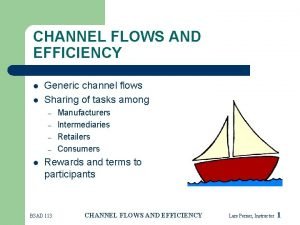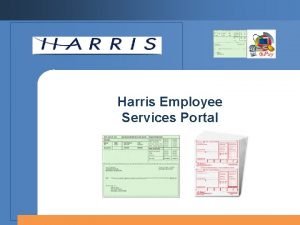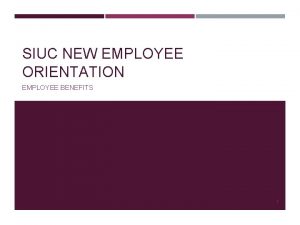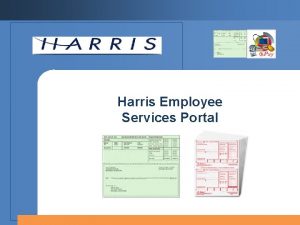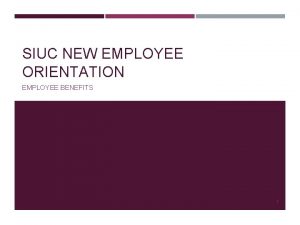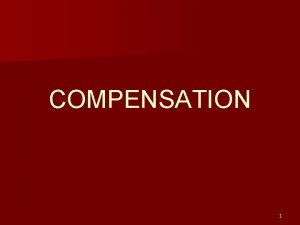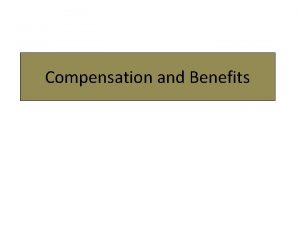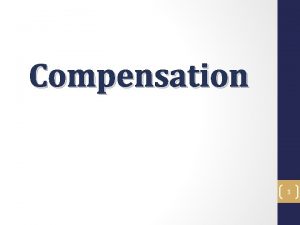EMPLOYEE COMPENSATION CHAPTER EIGHT WHAT IS COMPENSATION Compensation














































- Slides: 46

EMPLOYEE COMPENSATION CHAPTER EIGHT

WHAT IS COMPENSATION? §Compensation is the package of quantifiable rewards an employee receives for his or her contribution to the organization. Includes three components: base compensation, pay incentives, and indirect compensation/benefits. §Base compensation-the fixed pay an employee receives on a regular basis, either in the form of a salary or as an hourly wage. §Pay incentive- a program designed to reward employees for good performance. e. g. , bonus

OBJECTIVE OF EMPLOYEE COMPENSATION §Support the achievement of business goals through high performance §Develop and support the organization’s culture §Define what is important in terms of behaviors and outcomes §Reward people fairly according to the value they create §Enhance employee motivation and commitment §Attract qualified employee and managers

CONSEQUENCE OF POOR COMPENSATION §Job dissatisfaction §Low job performance §Absenteeism §Turnover §Strike and increased complaints 5

TYPES OF COMPENSATION 1. Direct compensation Whereby the employer provides monetary rewards for work done and performance results achieved. Base pay and variable pay are the most common forms of direct compensation.

DIRECT COMPENSATION 1. Base Pay – is the basic compensation that an employee receives, usually as a wage or a salary. § Wage- are payments calculated based on time worked. § Salary- employees receive the same payment each period regardless of the number of hours worked.

DIRECT COMPENSATION 2. Variable Pay – is another type of direct pay in which compensation is linked directly to individual, team, or organizational performance. §variable pays are incentives for performance. Assumptions of variable pay: • Some jobs contribute more to organizational success than others • Employees who perform better should receive more compensation • Employees’ compensation should be tied directly to performance and results

DIRECT COMPENSATION categories of Variable Pay 1. Individual incentives §are given to reward the effort and performance of individuals. Examples of individual variable pay are piece rate systems, sales commissions, and individual bonuses. Straight piece-rate system-pay system in which wages are determined by multiplying the number of units produced by the piece rate for one unit. Bonus - One-time payment that does not become part of the employee’s base pay. Spot bonuses - are given for extra efforts, or for completing an especially

DIRECT COMPENSATION When to use individual incentives: - §Individual performance must be identified §Individual competitiveness must be desired

DIRECT COMPENSATION Categories of Variable Pay 2. Team incentives §Are given to reward the effort and performance of a team. §The most common team incentives are gainsharing or goal sharing plans, in which the employees on a team that meets certain goals, as measured against performance targets, share in the gains. Often such programs focus on quality improvement, cost reduction, and other measurable results. § Gainsharing/teamsharing/goalsharing- the system of sharing with employees greater-than-expected gains in profits and/or productivity.

DIRECT COMPENSATION 2. The two primary Ways for distributing Team incentives: §Same-size reward for each member: all members receive the same payout, regardless of job level, current pay, seniority, or individual performance differences. §Different-size reward for each member: employers vary individual rewards depending on such factors as contribution to group/team results, current pay, years of experience, and skill levels of jobs performed.

DIRECT COMPENSATION When to use team incentives: - §Cooperation is necessary to do the jobs §Individual performances cannot be identified §Management wants teamwork §The reward system is seen as fair §Employees have input into incentive design

DIRECT COMPENSATION Categories of Variable Pay 3. Organizational incentives §Reward people according to the performance results of the entire organization. This approach assumes that all employees working together can generate improved organizational results that lead to better financial performance. These programs often share some of the financial gains made by the firm with employees through payments calculated as a percentage of the employees’ base pay. The most common forms of organization wide incentives are profit-

DIRECT COMPENSATION 3. Organizational incentives §Profit-sharing plans-profit sharing system to distribute a portion of the profits of an organization to employees. §Employee stock plans- Plan that gives employees the right to purchase a fixed number of shares of company stock at a specified price for a limited period of time.

INDIRECT COMPENSATION Benefits - is an indirect reward given to an employee or group of employees for organizational membership. Benefits are given to an employee or a group of employees for organizational membership, regardless of performance. §All financial rewards that are not paid directly to the employee Rational for employee benefits: - §help create and maintain competitive advantages §Workforce Attraction and Retention

EMPLOYEE BENEFIT STRATEGIES AND POLICIES Employee benefit policies are concerned with: the types of benefits to be provided, taking into account their value to employees, their cost and the need to make the benefit package competitive; the size of the benefits the total costs of benefits provision in relation to the costs of basic pay the use of flexible benefits, allows employees to select the benefits they prefer from groups of benefits established by the employer.

CHOICE OF BENEFITS The factors affecting the choice of or provision benefits are : Legal obligation what employees want, as established by opinion surveys; what other employers are providing, as established by market surveys; what the organization can afford.

TYPES OF BENEFITS §Government mandated benefits §Benefits employers must provide for employees by law. Which includes: §Pension §Leave (annual, sick, maternity, paternity. . ) §public holiday §Severance pay

TYPES OF BENEFITS §Voluntary benefits Employers voluntarily offer other types of benefits to help them compete for and retain employees. E. g. , housing allowance, educational assistance, health insurance, food service/subsidized cafeterias, tuition fee for children. . . ).

NON-FINANCIAL COMPENSATION Focuses on enhancing satisfaction from job itself or from psychological and/or physical environment in which employee work. Non financial compensation includes: - §Organizational support- is the degree to which employees believe an organization values their contribution and cares about their well-being. §Supportive supervisors §Participation in decision making §Fair reward system

REWARDING JOB AS A NONFINANCIAL COMPENSATION FACTOR following questions can provide considerable insight into value of job: Is job meaningful and challenging? Is there recognition for accomplishment? Do I get a feeling of achievement from doing the job? Is there possibility for increased responsibility? Is there opportunity for growth and advancement? Do I enjoy doing the job itself?

JOB ENVIRONMENT AS A NONFINANCIAL COMPENSATION FACTOR §Sound policies §Capable managers §Competent and friendly coworkers §Working conditions §Work-life balance

FACTORS AFFECTING EMPLOYEE COMPENSATION SYSTEM

FACTORS NEED TO BE CONSIDERED IN DESIGNING COMPENSATION SYSTEMS Equity The perceived fairness of what a person does (inputs) and what the person receives (outcomes). Internal Equity -means that employees receive compensation in relation to the knowledge, skills, and abilities (KSAs) they use in their jobs, as well as their responsibilities and accomplishments. External Equity- the perceived fairness of what a person receives when compared to another employee performing similar jobs in other organizations.

FACTORS NEED TO BE CONSIDERED IN DESIGNING COMPENSATION SYSTEMS Procedural justice- is the perceived fairness of the process and procedures used to make decisions about employees, including their pay. Such as, the entire process of determining base pay for jobs, allocating pay increases, and measuring performance must be perceived as fair. Distributive justice- the employee’s perceived fairness of the amount rewards among individuals and who received them. example, if a hardworking employee whose performance is outstanding receives the same across-the-board raise as an employee with mediocre performance, then inequity may be perceived.

FACTORS NEED TO BE CONSIDERED IN DESIGNING COMPENSATION SYSTEMS Job Versus Individual Pay: will compensation be based on how the company values a particular job, or will it be based on how much skill and knowledge an employee brings to that job? knowledge-based pay or skill-based pay A pay system in which employees are paid on the basis of the jobs they can do or talents they have that can be successfully applied to a variety of tasks and situations.

JOB VERSUS INDIVIDUAL PAY Job based pay §Technology is stable Individual based pay §Turnover is relatively low §The company’s technology and organizational structure change frequently. §Jobs are fairly standardized within the industry §The costs of employee turnover and absenteeism are high. §Employees are expected to move up through the ranks over time §Opportunities for upward mobility are limited. §Jobs do not change often §Opportunities to learn new skills are present.

FACTORS NEED TO BE CONSIDERED IN DESIGNING COMPENSATION SYSTEMS Egalitarianism Versus Elitism Egalitarian pay system- A pay plan in which most employees are part of the same compensation system. Elitist pay system- A pay plan in which different compensation systems are established for employees or groups at different organizational levels.

FACTORS NEED TO BE CONSIDERED IN DESIGNING COMPENSATION SYSTEMS Monetary Versus Nonmonetary rewards Will the compensation plan emphasize motivating employees through monetary rewards like pay or will it stress nonmonetary rewards such as interesting work? Centralization Versus Decentralization of Pay Decisions In a centralized system, pay decisions are tightly controlled in a central location such as headquarters. In a decentralized system, pay decisions are delegated to managers of each unit.

FACTORS NEED TO BE CONSIDERED IN DESIGNING COMPENSATION SYSTEMS Openness vs Pay Secrecy- another equity issue concerns the degree of secrecy that organizations have regarding their pay systems. Pay information that may be kept secret includes how much others make, what raises others have received, and even what pay grades and ranges exist in the organization.

HOW TO DETERMINE PAY /CONSTRUCT SALARY SCALE 1. Job analysis (job description and job specification) 2. Job evaluation & grading 3. Pay survey 4. Pay structure

JOB EVALUATION Job evaluation is a systematic process for defining the relative worth or size of jobs within an organization Is a method which helps to establish a justified rank order of jobs as a whole, being a foundation for the setting of wages. Job analysis (job description and job specification) is a prerequisite for job evaluation

PURPOSE OF JOB EVALUATION It is particularly important as a means of achieving equal pay for work of equal value. Produce the information required to design and maintain equitable and defensible grade and pay structures;

TYPES OF JOB EVALUATION Non analytical Take a whole job, compare it with others and on this basis position it in a job hierarchy Analytical Involves reducing the essential characteristics of a job to a number of factors and making a factorby factor comparison

RANKING Is a simple method It involves placing jobs in the ranked order based on the demands they are considered to make on those who perform them. Ranking of Jobs can be done on the basis of job titles or based on simple description of the job as a whole.

RANKING METHOD Advantage §Simple §Requires less time Disadvantage §does not provide a very precise measure of each job’s worth §Very difficult to use if there is a large number of jobs

CLASSIFICATION Is a method whose main characteristic is that the various grades and their structure are established before the jobs are ranked. All the jobs are then slotted into their appropriate grades by reference to the definition of the grades.

ADVANTAGE OF CLASSIFICATION Advantage Simplicity Easy to apply Takes less time Disadvantage Difficulty to develop exhaustive description of grades Limitation in determining the relative value of jobs

POINT RATING Is the most common analytical approach Requires developing a ‘factor plan’ which is defined as the factors and their levels and attaches scores to each level. These factors should be present in all the jobs to be evaluated and the different levels at which they are present indicate relative job value.

VALUING JOBS USING MARKET PRICING Market pricing is the use of market pay data to identify the relative value of jobs based on what other employers pay for similar jobs. Advantages of Market Pricing It closely ties organizational pay levels to what is actually occurring in the market, Disadvantage of market pricing Pay survey data are limited The responsibilities of a specific job in a company may be somewhat different from those of the “matching” job identified in the survey.

PAY SURVEY Pay survey is a collection of data on compensation rates for workers performing similar jobs in other organizations. In order to conduct pay survey identifying benchmarking jobs is important. Benchmark jobs Jobs found in many organizations that can be used for the purposes of comparison.

PAY SURVEY Factors to consider in conducting Pay survey: Does the survey cover a realistic sample of the employers with whom the organization competes for employees? How current are the data (determined by the date the survey was conducted)? How qualified are those who conducted it? Does the survey contain job summaries so that appropriate matches to job descriptions can be made?

POLICY CHOICES TO DETERMINE PAY Pay level determination policy “Lead the Market” Strategy- employers using this strategy pay above market average. This strategy generally enables a company to attract and retain sufficient workers with the required capabilities and to be more selective when hiring. Because it is a higher-cost approach, organizations often look for ways to increase the productivity of employees.

POLICY CHOICES TO DETERMINE PAY Pay level determination policy Meet the Market Strategy – is about choosing to paying the market average employers following this strategy choose to position themselves in the middle of the market, i. e. , they pay the market average as identified by pay data from surveys of other employers’ compensation plans. Choosing this level attempts to balance employer cost pressures and the need to attract and retain employees.

POLICY CHOICES TO DETERMINE PAY Pay level determination policy “Lag the Market” Strategy- an employer using this strategy choose to pay below market levels, for several reasons. Reason for following this strategy: If the employer is experiencing a shortage of funds when an abundance of workers is available, Disadvantage Increases the likelihood of higher worker turnover.

FACTORS AFFECTING POLICY CHOICES §The financial resources available §Competitiveness pressures, and §Availability of employees in the market with different capabilities
 Plane figures and solid figures
Plane figures and solid figures A short section of corrugated roadway that warns of hazards
A short section of corrugated roadway that warns of hazards Employee attitudes and employee performance
Employee attitudes and employee performance Noncompensation
Noncompensation What happens in the great gatsby chapter 8
What happens in the great gatsby chapter 8 Chapter 8 lord of the flies short summary
Chapter 8 lord of the flies short summary Chapter 6 employee testing and selection ppt
Chapter 6 employee testing and selection ppt Chapter 16: employee safety and health
Chapter 16: employee safety and health Whats a quarter past 12
Whats a quarter past 12 What happened 8 years ago today
What happened 8 years ago today It's twenty to nine
It's twenty to nine 8 tourism sectors
8 tourism sectors Eight elements of culture
Eight elements of culture Lesson eight credit cards
Lesson eight credit cards Symbol in map
Symbol in map Eight generic channel flows
Eight generic channel flows Central eight risk factors
Central eight risk factors A crane lowers a girder into place
A crane lowers a girder into place Poetry terms and examples
Poetry terms and examples Five six seven eight
Five six seven eight Central eight risk factors
Central eight risk factors Zero one two three four five six seven eight nine ten
Zero one two three four five six seven eight nine ten The 8 levels of classification
The 8 levels of classification It's not how smart you are it's how you are smart
It's not how smart you are it's how you are smart Eight basic puzzles about financial structure
Eight basic puzzles about financial structure Public statement by eight alabama clergymen
Public statement by eight alabama clergymen In a school assembly eight children
In a school assembly eight children Eight year old hyphen
Eight year old hyphen Female villain archetypes
Female villain archetypes 8-1 factors and greatest common factors
8-1 factors and greatest common factors Eight guiding principles of eia
Eight guiding principles of eia Novelty in news values
Novelty in news values Sea eight maritime services
Sea eight maritime services Ceyx and alcyone summary
Ceyx and alcyone summary Importance of qualitative research
Importance of qualitative research Decision-making process 8 steps
Decision-making process 8 steps I have 6 faces and 8 vertices
I have 6 faces and 8 vertices 8 great ideas of computer architecture
8 great ideas of computer architecture The 8 taxonomic groups
The 8 taxonomic groups 8 levels of classification in order
8 levels of classification in order Archaebacteria eubacteria
Archaebacteria eubacteria Characteristics of life project
Characteristics of life project What are the eight levels of classification
What are the eight levels of classification Robert plutchik's emotion wheel proposes that
Robert plutchik's emotion wheel proposes that Eight generic channel flows
Eight generic channel flows Balutan figure of eight
Balutan figure of eight Central eight risk factors
Central eight risk factors



